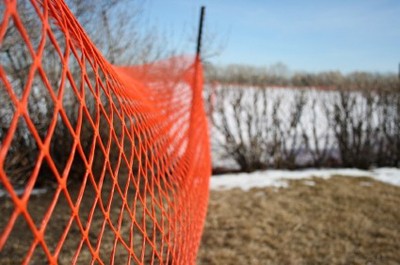
If you live in an area with harsh winters, strong winds and steady snowfall can create a lot of drifting snow. Believe it or not, this presents you with a great opportunity to conserve water. By installing a snow fence, you can effectively capture snow and create drifts in areas where you need additional snow to melt in the spring.
The principle behind how snow fences work is simple: fences act as windbreaks that slow down the speed of wind-driven snow and cause it to be deposited as drifts. This makes snow fences a simple and effective device for things like reducing the amount of snow on roadways, controlling avalanches at ski resorts, and preventing the erosion of sand dunes on beaches. Here's how snow fences can help in the garden:
There are two type of snow fences: man-made and living. Both have their advantages and disadvantages. The type you choose depends on your budget, and whether or not you want the structure to be permanent or temporary.
Man-Made: Man-made snow fences are usually constructed of wooden slats (held together with wire) or from a lightweight, plastic mesh. They are inexpensive, easy-to-install and remove, and can be "fine-tuned" to control the effects of snowfall.
Advantages: Inexpensive, easy to install and remove, adjustable.
Disadvantages: Not as attractive, eventually needs to be repaired or replaced.
Living: Living snow fences can be made from trees, shrubs, native grasses, or even landscaping berms (small hills). They come with a higher initial installation cost, but once established add increased value to your landscape.
Advantages: Attractive, adds value, provides additional food for you and/or wildlife.
Disadvantages: Increased installation cost, needs time to grow, non-adjustable.
To control snow, determine the prevailing wind direction, and position the fence upwind of the desired drift area.Height: The taller the fence, the more snow that will be trapped. Most commercially sold snow fences come in 4 foot heights.
Length: Extend your fence approximately 30% wider on either side of the area you are trying to protect/control.
Set Back: Various formulas exist regarding how far back your fence should be set back from the desired drift area (e.g. a distance of 30 times the height of the fence). Most formulas are based on controlling snow near large open spaces like fields along roadways. In less open areas (like gardens), a bit of guesswork is involved. In general, you can expect drifts to accumulate on the leeward side of your fence at a distance of anywhere from 5 to 15 times its height. The determining factors include the average snowfall in your area, wind speeds, and the proximity of nearby structures.

About The Author: Ellen Brown is an environmental writer and photographer and the owner of Sustainable Media, an environmental media company that specializes in helping businesses and organizations promote eco-friendly products and services.
Add your voice! Click below to comment. ThriftyFun is powered by your wisdom!